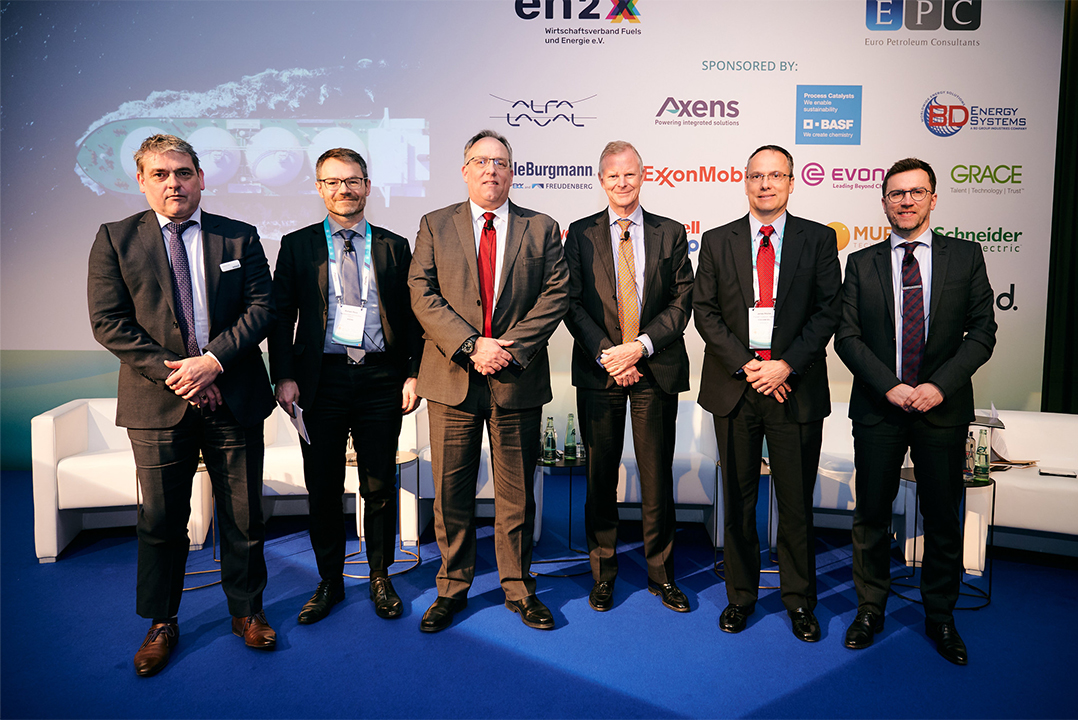During ESF Europe that took place from 21-23 March in Berlin, our VP Stefan Chapman had the honour of moderating a discussion with the leading industry experts; James Ritchie, President, EXXONMOBIL CATALYSTS & LISCENING, Roeland Baan, President & CEO, TOPSOE A/S, Bryan Glover, President & CEO, HONEYWELL UOP, Damon Hill, President Growth and Projects, WOOD and Romain Roux, Decarbonisation & Consulting Director, AXENS (filling in for Jean Sentenac, President & CEO, AXENS) focused on the importance of choosing the right solutions in decarbonising the downstream industry and they shared the available solutions and technologies that will assist producers in reaching their net zero goals. Technology plays a crucial role in the energy transition, and as such licensors have a central role to play.

From left to right: Damon Hill, WOOD - Romain Roux, AXENS - Bryan Glover, HONEYWELL UOP, Roeland Baan, TOPSOE A/S, James Ritchie, EXXONMOBIL CATALYSTS & LISCENING & Stephan Chapman, Euro Petroleum Consultants
The panel began by discussing the current global geopolitical landscape and impact on the energy transition. Despite two years of the pandemic which has provided long-lasting impacts on the industry and society as a whole, we are still not in the clear yet. Coupled with the devastating war in Ukraine, the industry is once again facing high energy prices and instability, creating difficulties to plan with so much volatility. In Europe, 40% of gas, 30% of oil and 40% of coal comes from Russia, highlighting Europe's dependency on energy imports. The situation has emphasised the need for the region to become independent and accelerate the development of alternative energy.
The European Commission announced the acceleration of their 2030 target in order to be less dependent on Russian energy imports, by diversification of gas supplies and larger volumes of biomethane and renewable hydrogen production and imports. Also in the plan is the aim to reduce the use of fossil fuels, increase energy efficiency, and renewables as well as electrification of the economy. The high cost of oil and natural gas creates opportunities for the region to develop renewable energy. For example, depending on the refiner's location, it may now be cheaper to produce green hydrogen rather than blue. Refiners and petrochemical producers must reduce scope 1 and 2 emissions through energy efficiency, carbon capture, and electrification but at the same time, the long-term oil decline means that the industry has to switch to petrochemicals and take into consideration plastic recycling, synthetic fuels and biofuels. It will certainly not be an easy journey, but with the investment, support, and technologies available, the industry can prevail in this aspect.
The situation has emphasised the need for the region to become independent and accelerate the development of alternative energy.
So, what routes should the European downstream industry focus on in order to meet consumer demand? There is significant diversity in Europe; location plays a big factor in the sequestering of CO2. In areas where carbon capture is available, the price begins to look attainable today. It is key for each refiner to determine what their geographical challenges and opportunities are. Within their conventional asset base, refiners should look at better molecular management and improving the efficiency of their assets. The focus for the downstream industry should be to bring down scope 3 emissions and to do it profitably, whilst at the same time tackling scope 1 & 2 emissions that are driven by regulation and subsidies. Today, there are a lot of opportunities to reduce scope 3 as most investments involve transitioning the product base away from fuels into petrochemicals, which provides significant profitability. A conventional refinery is most likely to become a petrochemical feedstock producer in the future. Beyond petrochemicals there are still a number of scope 3 opportunities that are available such as renewable fuels (either for diesel or SAF) and producing green naphtha and green LPG that can go into petrochemical production, where there are already significant premiums available. For refiners, anything that moves them into diesel, propylene and ethylene can be an attractive route before addressing scope 1 and 2 emissions.

Despite the industry’s continuous improvements to operations, there are still low hanging fruits to be had. The basis always starts with running operations correctly, efficiently and using advanced monitoring tools. However, during the pandemic, refiners were placed into panic mode, running catalysts to the end, holding back on capital, which in turn comes at a cost to GHG emissions and energy efficiency. There are a vast range of technologies out there that offer different advantages depending on producers’ constraints, whether it’s a catalyst that gives better yield or lower energy usage. When evaluating the best solutions, taking a holistic approach together with life cycle analysis is key. As times change, refiners need to be continuously looking at valuation, driving them to do different things, whilst at the same time utilising their current assets to move towards a decarbonised future. It’s survival of the fittest which usually goes with scale and integration.
When evaluating the best solutions, taking a holistic approach together with life cycle analysis is key.
The discussion moved on to the question of ‘are we moving fast enough?’ For example, green hydrogen installed capacity through electrolysis currently in the world is 300 MW. However, since the Ukraine crisis, we now need 400 GW by the end of this decade for Europe alone - but where is this going to come from? The industry needs to move faster to meet this challenge. In terms of petrochemicals, the opportunities exist, however, the industry as a whole is not moving fast enough in embracing petrochemical integration. Cost is a major factor; however, the ROI is positive along with reducing scope 3 emissions. Those who reposition quickly are going to have an advantage. We see great numbers in renewable energy, but the resources required to design, procure and build aren’t there yet, and the supply chain isn’t in any shape to deliver what’s needed in the next decade. On another note, the industry can only move as fast as the consumers and the push from activists is helping the industry to transition. The end goal for all is to combat climate change, but we require ways of making it happen competitively for society to keep moving.
In terms of new technologies, the panellists began to debate as to whether it’s better to be a front runner or first fastest follower. If the region has predictable, consistent, and reliable government regulation then it’s better to be first. However, this often isn’t the case and the goalposts keep moving, meaning the one in charge isn’t always the final winner. New technologies take time to develop, and get to market. Historically, with new technologies on the market it’s common to sell one or two units over the course of a couple years. However today, the demand for sustainable technologies is extremely high meaning there may be multiple units built in a short period of time. The paradigm is shifting meaning whether you’re first or fast, all technology providers must work together to get the technology out there quick enough. Another factor to consider is that today the front runners in many areas such as hydrogen and plastic recycling are start-ups, not the typical big technology companies. This is where further collaboration is needed to deliver the technology to scale. One technology solution isn’t going to be the final answer but instead, a mix of what’s available and best for that particular location, further highlighting that the collaboration between technology companies is key.
